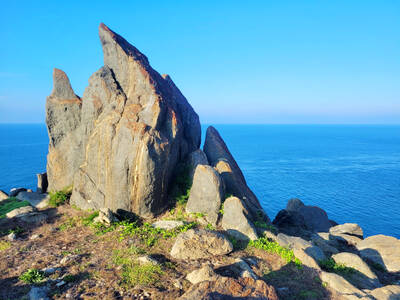D espite the 35˚C heat, at least 20 people sat perched outside the Melange Cafe one lunchtime last month waiting for a seat. By 2pm, their numbers had doubled. Such crowds are typical for the Zhongshan North Road establishment, which enjoys a favorable reputation because of its urban chic setting and afternoon tea fare: coffee and
tea drinks, Belgian-style waffles and sandwiches.
Other reasons for the long lines are that the cafe doesn’t accept reservations and also seems to attract large parties of ladies who lunch, female shoppers in their 20s and kids on summer break. But it is definitely possible to get a seat quickly — go alone or with one companion and ask to the sit at the bar.
Melange has remained as popular as ever since the Taipei Times last visited the cafe at its old location on Nanjing West Road in 2004. Moreover, the new location’s decor, which is a departure from the Japanese coffee house ambiance of its Nanjing West Road days and now feels more like a European-style cafe, offers a better first impression.
It’s hard not to admire the bar’s spacious and smooth white marble-top counter, which is cool to the touch and easy on the eyes.
Trendy-looking cafes in Taipei tend to overdo their sandwiches, but Melange hits the right notes with its club sandwich (NT$110), a very reasonable price considering the sandwich’s quality. The cafe keeps its ingredients simple: non-sweet white flour bread, smoked chicken that does without the strong taste of artificial flavoring, ham, thinly sliced scrambled egg, and a light spread of mayonnaise.
Melange Cafe seems to take a near fanatical pride in its beverages, which take up a lot of the menu, on which they are adorned with art deco-like motifs. Patrons are asked to purchase a drink of at least NT$90, whether for dining in or take-out, and food doesn’t count towards this minimum charge. The “summer fruit tea,” (NT$150), which a waiter noted as a popular choice, is a mix of brewed black tea (Lipton yellow label), fresh apple slices, kumquat and passion fruit.
The drink didn’t elicit any “wows” from this reviewer, but was refreshing enough and well presented, arriving in a mini-glass pitcher along with a small wine glass. Another house recommendation is the green tea au lait (NT$120), which uses green tea powder imported from Japan.
One friendly regular sitting at the bar, a woman who appeared to be in her late 60s, said she stops in once a day for coffee because of the “freshness of the beans” and the attentive service she receives from the white uniformed, beret-wearing staff. She might also appreciate the fact that the drip-blend coffees, which include Blue Mountain No. 1 and Kenyan AA and range in price from NT$100 to NT$180, come in porcelain cups that are immersed in hot water while the drink is brewing.
A few Taiwanese foodie blogs point out that the strawberries and cream with waffles dish (NT$140) is reason enough to go, but the waffle with green tea ice cream and sweet red beans (NT$130) was saccharine to the point that it generated a sugar overload. The waffles, though served fresh and hot, were a tad too sweet and had the consistency of cake dough.
Melange Cafe is close to Zhongshan MRT Station (中山捷運站), Exit 2.

One of the most important gripes that Taiwanese have about the Democratic Progressive Party (DPP) is that it has failed to deliver concretely on higher wages, housing prices and other bread-and-butter issues. The parallel complaint is that the DPP cares only about glamor issues, such as removing markers of Chinese Nationalist Party (KMT) colonialism by renaming them, or what the KMT codes as “de-Sinification.” Once again, as a critical election looms, the DPP is presenting evidence for that charge. The KMT was quick to jump on the recent proposal of the Ministry of the Interior (MOI) to rename roads that symbolize

On the evening of June 1, Control Yuan Secretary-General Lee Chun-yi (李俊俋) apologized and resigned in disgrace. His crime was instructing his driver to use a Control Yuan vehicle to transport his dog to a pet grooming salon. The Control Yuan is the government branch that investigates, audits and impeaches government officials for, among other things, misuse of government funds, so his misuse of a government vehicle was highly inappropriate. If this story were told to anyone living in the golden era of swaggering gangsters, flashy nouveau riche businessmen, and corrupt “black gold” politics of the 1980s and 1990s, they would have laughed.

It was just before 6am on a sunny November morning and I could hardly contain my excitement as I arrived at the wharf where I would catch the boat to one of Penghu’s most difficult-to-access islands, a trip that had been on my list for nearly a decade. Little did I know, my dream would soon be crushed. Unsure about which boat was heading to Huayu (花嶼), I found someone who appeared to be a local and asked if this was the right place to wait. “Oh, the boat to Huayu’s been canceled today,” she told me. I couldn’t believe my ears. Surely,

When Lisa, 20, laces into her ultra-high heels for her shift at a strip club in Ukraine’s Kharkiv, she knows that aside from dancing, she will have to comfort traumatized soldiers. Since Russia’s 2022 invasion, exhausted troops are the main clientele of the Flash Dancers club in the center of the northeastern city, just 20 kilometers from Russian forces. For some customers, it provides an “escape” from the war, said Valerya Zavatska — a 25-year-old law graduate who runs the club with her mother, an ex-dancer. But many are not there just for the show. They “want to talk about what hurts,” she